National Dry Eye Awareness Month
What Causes Dry Eyes?
Our tears serve a purpose, they are designed to provide much needed moisture to our eyes. Later in life, some of us can experience dry eyes, a condition in which the eyes do not provide the moisture we need.
Dry eye is a multi factorial disease. Sometimes it can occur if the immune system attacks the lacrimal glands and our eyes fail to produce enough tears. It also may be secondary to chronic inflammation of the lids, when the oil glands in the lids don’t produce enough oil. It can also be a combination of both.
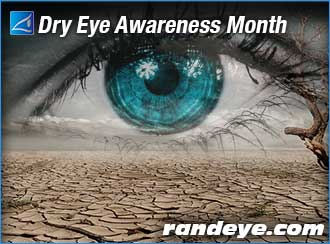
Who is most Likely to Experience Dry Eyes?
Dry eye is a condition more commonly found in females, especially those who are post-menopausal. It can, however, be found in either gender, typically after the age of 50 and more commonly after age 65. It is important to know that dry eyes can occur at any age.
How You Can Tell if You Have Dry Eye
Symptoms include eye irritation or the sensation of a foreign body in the eye. You might experience discomfort after a few minutes of reading, and strangely enough, even watery eyes. Your eyes may sting or burn. You may experience dry eye in specific situations, such as on an airplane, in an air-conditioned room, while riding a bicycle, in an open convertible or after looking at a computer screen for an extended period of time.
How Could Watery Eyes be a Symptom of Dry Eyes?
It seems counterintuitive, but tearing can be a sign of dry eye. We have two kinds of tears: the basal secretion tears that keep the eyes lubricated, and reflex tears, which are watery and abundant. Normally, reflex tears occur after a stimulus, such as a grain of sand that becomes trapped in your eye. The natural defense of the ocular surface is to try to wash it out. It can also be a reflex to an emotional stimulus, such as crying because you’re sad or if you are slicing an onion. If you have insufficient basal secretion tears, and your eyes get irritated, this can stimulate reflex tears.
How Often We See Dry Eyes at Rand Eye Institute
Dry eye is very common. Most people who have had eye exams know that artificial tears are available. Many patients come to Rand Eye Institute for other reasons, but during the eye exam we may find they have dry eyes in addition to other conditions such as cataracts or glaucoma. Many patients may have had symptoms for awhile, but have not been diagnosed with dry eye until we examine them and connect their symptoms with the correct diagnosis.
Article source: Gabriel E. Velazquez, MD, Academic Director at Rand Eye Institute
Senior Independence Month
We’ve SEEN your Independence, and we like what we see!
Rand Eye Institute celebrates Senior Independence Month. We salute our seniors who have the Vision to live in the new millennium in a positive and upbeat manner. As we get older, we realize that we need the help of friends and family in our day-to-day lives. Maybe we can no longer safely commute in rush hour traffic, carry groceries up three flights of stairs, or even see things as clearly as we used to. The truth is, no one wants to feel helpless and dependent upon others for everything, and while sooner or later we’ll have to surrender some of those tasks, there are still ways to feel independent and useful in your own life. Here are some of the ways when it comes to vision:

Take a Drive on Independence Road
We all enjoy a Sunday ride or a scenic road trip, navigating towards making new memories along the way and vision plays an important role in achieving this. If you love dinners out with friends or night-time entertainment, having restrictions on your driving will surely place a limitation on your fun. When you start to experience difficulty driving at night and seeing increased glare and halos from oncoming headlights, it’s time to visit your ophthalmologist. You may be experiencing the signs of cataracts, but great news, with the latest advancements in laser cataract surgery you may regain your independence and get behind the wheel in no time. So jump back in the driver seat, take control of your vision and buckle up-the road ahead awaits you!
Stay Connected and Up to Date
Do you remember the days when you had to get up from the couch to change the channel? Well, just like remote controls, technology is your friend and helps you stay in touch with friends and family. To be a most effective digital communicator you need clear vision, not just at a distance, but up close and clear intermediate vision helps you see your laptop or smartphone in focus. A small laptop with a wireless connection is all you need. You can download free video-chat programs so you can “connect” with your kids and grandkids, or one of the most popular “face-to-face” apps available on mobile phones. Your local technology stores even offer free group classes to teach you how to do it all. E-mail and texting are great ways to send and receive photos of the kids too. Connectivity promotes vitality and makes you feel good that you’re in touch with today, and with the exception of the purchasing a computer or mobile device, it’s virtually free. Many restaurants, coffee shops and malls offer free wireless “wi-fi” connections, while libraries have computers for use at no charge. So log on and live life with new connections!
Healthy Eating Can Equal Healthy Vision
Being independent means that YOU choose what you eat. And while your menu may be all your own, making informed food choices can help to improve your eye health. Here are five foods your eyes wish you would include in your diet:
- Carrots, rich in beta-carotene. You SAW that coming!
- Leafy-greens, which are packed with lutein and, lower the risk of macular degeneration and cataracts.
- Eggs. The yolk is also a prime source of lutein and Zeaxanthin as well as zinc, which helps reduce the risk of macular degeneration.
- Citrus and berries, which are packed with vitamin C. Can you say “smoothie”?
- Almonds are filled with vitamin E and one ounce daily just about gets it done.
- Fish, like tuna, salmon, mackerel, trout and even anchovies add the fatty acid, DHA, which is good for your eyes, see?
And Finally, your Independent Opinions Are All Your Own
We all have our own voice. While not everyone will agree with you and your opinions, you should still believe in yourself, after all, you come with a lifetime of experiences and no one can dispute that. You can offer your opinions without being confrontational. So say what you believe, believe what you say and believe in yourself, because you’re awesome!
So starting today: Get connected, take care of yourself, let others contribute to your well-being, express your opinions on the move and make healthy choices at the dinner table, and, before long, you’ll find that you’re much happier in your senior life.
Fireworks Eye Safety on the 4th of July
We live in the land of the free, so we get to celebrate our love for America every year on the 4th of July. We barbecue, swim, play sports, get together with friends and family, and traditionally, we watch fireworks. Many of us take part in the setting off of fireworks. Know the law where you live concerning the use of personal fireworks, and know one other thing for sure: The law of averages could make you a statistic.

Thousands of people in the U.S. every year, many of them children, suffer eye injuries caused by fireworks. In the most severe cases, fireworks can rupture the globe of the eye, cause chemical and thermal burns, corneal abrasions and retinal detachment — all of which can permanently cause eye damage and affect vision.
In the year 2014, more than 10,500 fireworks-related injuries required treatment in an emergency room in the U.S., according to a recent fireworks injury report from the U.S. Consumer Product Safety Commission. Roughly 1 in 5 of those fireworks injuries was to the eyes and nearly half of those injured were bystanders, with children being frequent victims.
Here are Some Handy Fireworks Safety Tips
The best way to avoid a potentially blinding fireworks injury is by attending a professional public fireworks show rather than purchasing fireworks for personal use.
- Respect safety barriers and view fireworks from at least 500 feet away.
- Do not touch-unexploded fireworks; instead, immediately contact the local fire or police department to assist. You should never touch or pick up previously exploded fireworks debris.
- Remember, pets don’t enjoy fireworks like people do. Explosions are much louder and more frightening to dogs and cats, so it’s best to leave your pet with friends in a safe environment rather than bringing them to a fireworks display.
**PLEASE NOTE FOR EMERGENCY EYE CARE – OUR OPHTHALMOLOGISTS ARE ON-CALL 24/7
For those who decide to purchase consumer fireworks in states where they are legal, we recommend the following safety tips to prevent eye injuries:
- Never let young children play with fireworks of any type, even sparklers.
- People who handle fireworks should always wear protective eyewear that meets the parameters set by the American National Standards Institute and ensure that all bystanders are also wearing eye protection.
- The very best tip: Leave the lighting of professional-grade fireworks to trained pyrotechnicians.
What to do in the event of a fireworks eye injury:
- Seek medical attention immediately.
- Do not rub your eyes.
- Do not rinse your eyes.
- Do not apply pressure.
- Do not remove any objects that are stuck in the eye.
- Do not apply ointments or take any blood-thinning pain medications such as aspirin or ibuprofen.
Your doctor or eye professional is the most qualified, trained professional who can offer you the best assistance. Remember, safety is always first when it comes to your eyes. You have but ONE SET, so please take care of them.
**Should you experience a medical eye emergency, such as an injury or trauma to the eye or to the area surrounding the eye, infection, sudden eye pain or decreased vision, please call our office immediately at 954-782-1700. Our ophthalmologists are on-call 24/7 and will contact you as soon as possible.
In the event of severe trauma to the eye, or if you believe you have an extreme time sensitive eye emergency; call 911 or go to the nearest hospital emergency room while waiting for our doctor to return your call. This would avoid a delay in critical care in case for any reason our response is not immediate.
Cataract Prevention is Possible
There are several ways to prolong cataract development, and one sensible way, is through nutrition. Certain nutrients and nutritional supplements may help you reduce your risk of developing cataracts, so take note of them and put them on a list for your next trip to the grocery store.
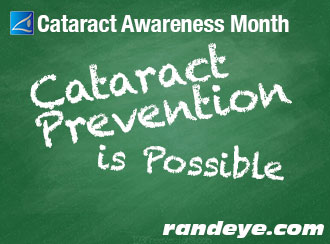
While shopping, don’t pass up some old favorites: Whole grain cereal, sunflower seeds, almonds, spinach and avocados, all good sources of vitamin E. Studies have shown that the risk of developing cataracts could be as much as 60% lower when you include these foods in a balanced diet. Don’t overlook kale and other green, leafy vegetables either. While some may not enjoy their taste, remember you can blend them into a tasty and healthy smoothie.
Antioxidant vitamins such as vitamin C and foods containing omega-3 fatty acids may also reduce your risk of developing cataracts, so look to add fish to your plate at least twice a week.
Lastly, an essential and easy step to reduce your risk of cataracts, and to add to overall eye protection, is to wear sunglasses that block 100 percent of the sun’s UV rays.
Cataract Surgery: Clarity in the Blink of an Eye
When symptoms of a cataract appear, you may be able to improve your vision temporarily by wearing new glasses, strong bifocals, magnification, appropriate lighting or other visual aids.
The best way to permanently treat a cataract is Rand Eye Institute’s laser cataract surgery procedure that removes the old, clouded lens and replaces it with a new, custom artificial one, restoring your vision and significantly improving your quality of life.
See Us and See the Best
While experiencing changes in your vision due to cataracts, consider Rand Eye Institute’s advanced cataract surgery technique as a viable solution. Its effective and relatively painless procedure will help you regain crystal-clear vision. Cataract surgery is the most frequently performed surgery in the U.S., with more than 3 million Americans undergoing this vision-restoring procedure each year. Ninety percent of those who have cataract surgery regain clear vision, in the range of 20/20 – 20/40. Call us at 954-782-1700 and schedule a comprehensive eye exam to get back to crystal-clear cataract-free vision.
What Causes Cataracts?
The natural aging process is the main cause of cataracts and the leading cause of vision loss in adults 55 and over.
Our eyes work like a camera, so when we look at an object, light rays reflect off of that object and enter the eye through the cornea. The lens behind the cornea focuses the rays onto the retina, which, in turn, converts the rays into electrical impulses that travel through the optic nerve to the brain. The brain then perceives the electrical impulses as an image.
Seeing depends upon this chain of events, but seeing clear, focused images depends largely upon having a crystal clear lens. Unfortunately, cataracts interfere with that clarity.
Here’s what happens:
- The lens is comprised mainly of water and protein. The protein is arranged in a way that is designed to keep the lens clear and allow light to pass.
- As we age, portions of the protein can clump together and cloud a small area of the lens. Known as a cataract, over time it may grow larger and cloud an even greater area of the lens, making it more difficult to see clearly.
Types of Cataracts:
- Sub capsular cataracts occur at the back of the lens. People with diabetes or those taking high doses of steroid medications have a greater risk of developing a sub capsular cataract.
- Nuclear cataracts form deep in the nucleus of the lens. Nuclear cataracts are most often associated with aging.
- Cortical cataracts are characterized by white, wedge-like opacities that begin to form in the periphery of the lens and work their way to the center in a spoke-like fashion. This type of cataract occurs in the lens cortex, which is the part of the lens that surrounds the central nucleus.
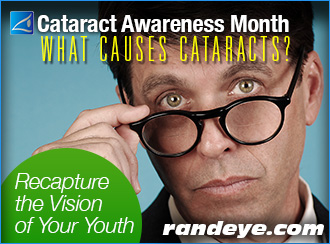
Other Common Causes:
- Ultraviolet radiation from sunlight and other sources
- Diabetes
- Hypertension
- Obesity
- Smoking
- Prolonged use of corticosteroid medications
- Statin medicines used to reduce cholesterol
- A previous eye injury or inflammation
- Previous eye surgery
- Hormone replacement therapy
- Significant alcohol consumption
- High myopia
- Family history
Fortunately, there is a procedure that can reverse the effect of cataracts, and it’s available here at The Rand Eye Institute. It’s LenSx® custom laser cataract surgery. It’s been called “a bold leap forward” and it represents one of the greatest surgical advances of our time.
Cataract Awareness – Leading Cause of Blindness
Cataracts are the leading cause of vision loss in the United States and the leading cause of blindness in the world. The American Academy of Ophthalmology reports that by age 75, about 70% of people will have cataracts.
What are Cataracts?
• A cataract is a clouding of the eye’s natural lens that affects many of us as we age.
• People with cataracts often have blurry or double vision, sunlight seems overly bright or glaring and they often have difficulty seeing at night.
• A cataract can occur in one or both eyes but cannot spread from one eye to the other.
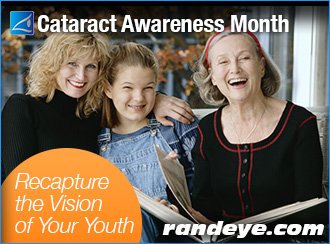
Cataract Characteristics
Adult cataracts develop slowly over time, beginning at around age 55. Visual problems that are associated with cataracts include:
- Being sensitive to glare
- Cloudy, fuzzy, foggy, or filmy vision
- Difficulty seeing at night or in dim light
- Double vision
- Loss of color intensity
- Problems seeing shapes against a background or differentiating between shades of colors
- Seeing halos around lights
Seeing Your Way Clear
Early diagnosis is important for maintaining good eye health. Fortunately, we live in a time when correcting cataracts is easily accessible, and the results you can get from The Rand Eye Institute can be extraordinary. Ask about Rand Eye’s Custom Laser Cataract Surgery with the LenSx® Procedure. Schedule a comprehensive eye exam today.
Hurricane Preparedness – Eye Safety Tips
Hurricane season is June 1st through November 30th. Forecasters at NOAA report that South Florida is in a “Hurricane Drought”, since our area has not endured a direct hit since Wilma crossed our state on October 24, 2005. Forecasters agree that now, more than ever, we should be alert and take the necessary precautions to prepare for an emergency, should we get a hurricane or other significant weather event.
Here are some hurricane tips for protecting your eyes:
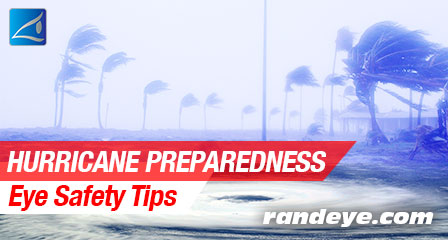
Safety First
- It may sound simple, but always wear eye protection when making hurricane preparations to your home. Even the smallest debris from drilling, or hammering nails into wood or concrete, could end up in your eyes. The easiest first step is to always wear goggles or protective eyewear.
- Make sure your tools are in good working condition, the hammer’s head is secure and that the nails and screws are not rusty or bent. Always wear a tool-belt when climbing ladders so that you can use your hands to safely steady yourself.
- If glass is breaking during a storm, put on protective eyewear and stay out of the path of flying glass or debris. Seek shelter in a protected area of your home.
- Read and follow label directions. Cleaning fluids, chemicals and gases could be dangerous, especially in combination with other substances. Wear gloves and protective eyewear at all times.
- Work with chemicals in a well-ventilated area and be sure that spray nozzles point away from you and others. Always wash your hands thoroughly afterward.
- Young children should not participate in dangerous storm preparation. If they are nearby, always provide protective eye wear or safety goggles for them. When working near debris or construction, wear sturdy shoes, not sandals or slippers.
- Avoid swimming in a pool or visiting a water attraction that may have become contaminated during a storm. Because of a power-outage or if there is storm debris in the pool, the water may be unsafe.
First Aid Eye Care
- Always have purified or bottled water on hand to rinse your eyes in the event that dust or other particles get into them. Do not rub your eyes, rinse them with purified water.
- Avoid using tap water in your eyes after a hurricane, since stagnant water may be contaminated. Again, have plenty of bottled water on hand.
- If debris hits the area around the eye, apply cold cloths for 15 minutes to reduce swelling. If swelling persists, see your doctor as soon as possible.
- If a sharp object like a twig or nail enters your eye, do not try to remove it yourself. Be careful not to apply pressure to the affected area. Go to a hospital or emergency room as soon as you safely can.
- Beware of chemicals splashing into your eyes, especially cleaning fluids, fuel or gasoline. If that happens, gently wash the eyes with purified water for at least 10 minutes. Go to a doctor or emergency room immediately. Never use a barbeque grill inside the home.
- Prepare Medicine and Supplies in Advance.
- Have a plentiful amount of your eye medications on hand as pharmacies may be closed during and after a storm. Store them in a clean, dry area for easy access.
- Keep eyeglasses and contact lens supplies where you can easily find them, including rewetting drops to refresh your eyes as needed.
There is often so much to do and much confusion during a hurricane, but always keep your eyes top of mind when preparing for a storm.
Eye Protection Tips – Wear Sunglasses
There are many easy ways to take care of your eyes; the most convenient is just throwing on a pair of your favorite sunglasses.
The Future’s so Bright You Gotta Wear Shades!
Sunglasses are a great fashion accessory, but they serve an even greater purpose than just making you look like a movie star! Their most important job is to protect your eyes from the sun’s ultraviolet (UV) rays. 
Here Comes The Sun!
Everyone knows that the sun’s rays are bad for our skin, but did you know that the sun can also do damage to your eyes? For example:
- Cataracts are a clouding of the eye’s lens that can blur vision. An estimated 20% of cases are caused by extended UV exposure.
- Macular degeneration, which results from damage to the retina that destroys central vision, is the leading cause of blindness in the United States.
- Pterygium, a tissue growth over the white part of the surface of the eye that can alter the curve of the eyeball, causes astigmatism.
So, Hats Off to Good Choices!
When choosing sunglasses, look for ones that block 99 to 100% of both UVA and UVB radiation, so you can keep your vision and your looks sharp and healthy. A hat offers great protection, too. So enjoy Healthy Vision Month by making smart vision choices.
Eye Health Care
Eyesight has the largest impact on our day-to-day life. Vision is the ONE sense that people fear losing the most. Pay attention to your eye health so that you can spot problem areas in your vision sooner.
Healthy Vision Month is a great time to learn more about eye health- care and an opportunity for you to gain a better understanding of how at-risk you may be for potential vision problems.
How do you know if YOU are at risk?
Many common eye diseases that can lead to vision loss or blindness, such as diabetic eye disease, glaucoma, or age-related macular degeneration (AMD), often have no early warning signs or symptoms. Scheduling regular eye exams to make sure your eyes are healthy and seeing their best is most important. However, the risk of vision loss and blindness is higher for some based on race, ethnicity, and other demographic and socioeconomic factors.
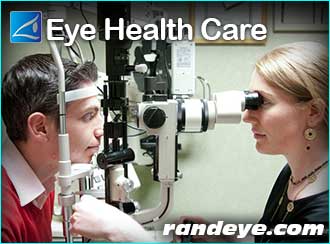
SEE if it’s you
You might be at higher risk for vision loss if you have a family history of eye disease; have diabetes; are African American, Hispanic/Latino, American Indian, or Alaska Native; or are older than age 50.
- Glaucoma affects your side or peripheral vision first. Turns out it’s three times more common in African Americans than in Caucasians, in fact, in African Americans it is a leading cause of blindness.
- Diabetic retinopathy can lead to blindness caused by uncontrolled diabetes. Studies show that it occurs more often in Hispanics/Latinos than in Caucasians.
- American Indians and Alaska Natives are 35 % more likely to get diabetes than the average adult in the U.S, putting them at increased risk of diabetic eye disease.
- Older adults are at higher risk of developing age-related eye diseases and conditions such as AMD, glaucoma, or cataracts. AMD is a leading cause of blindness in Caucasians.
What does all this mean? It means that now more than ever, you should look to The Rand Eye Institute for all of your vision needs. Schedule your yearly comprehensive eye exam today to maintain healthy eyes all year long.
Johnny’s No-Flap LASIK (Episode 5) – 4 months follow-up
Johnny’s No-Flap LASIK – (Episode 5) – 4 months after No-Flap LASIK
Johnny first came to the Rand Eye Institute for a vision consultation, to see if he was a Laser Vision Correction(No-Flap LASIK) candidate. He was!
It’s been 4 months since Johnny had his No-Flap LASIK procedure with Dr. Allison L. Rand. Johnny’s had wonderful results! He is now glasses free and can enjoy life without the need for glasses, or contact lenses, to correct his vision.
“For anyone that’s considering (No-Flap) LASIK, I would highly recommend having it here at the Rand Eye Institute.”
- J. Marino
